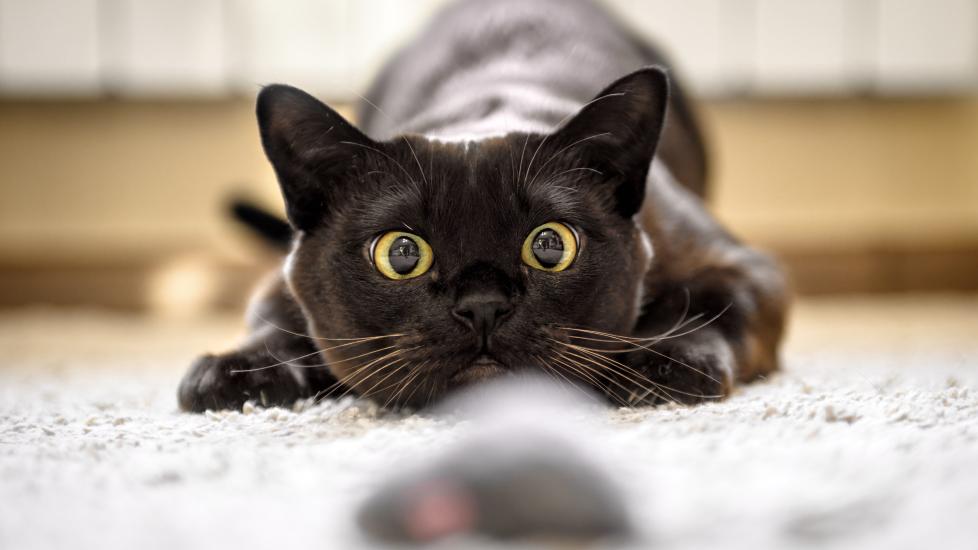Why Do Cats Wiggle Before They Pounce?
iStock/scaliger
Almost every cat parent has seen their furry feline stalk a favorite toy. They crouch low to the ground and wiggle their hind end back and forth before pouncing, ending the hunt by successfully capturing their “prey.”
The butt wiggle is undoubtedly cute and entertaining, but it also serves a few practical purposes for cats.
Key Takeaways
- There are a few theories about why cats “wiggle” their rear end before pouncing.
- Some believe wiggling increases their stability before leaping, while others believe it’s just for fun, since hunting and playing releases dopamine.
- Kittens begin practicing pouncing as early as 6–7 weeks old, often by mimicking their mother.
What Causes the Butt Wiggle in a Cat That’s About To Pounce?
Currently, there is very little formal, peer-reviewed research into butt wiggling in cats.
However, some believe the increased traction from butt wiggling—along with preparing the cat’s vision, balance, and muscular system for pouncing—is the most likely explanation.
Here are some of the most common theories about this behavior.
1. Cats Wiggle for Stability
One of the main explanations for the butt wiggle has to do with the differences in how cats move their hind legs when they are walking versus pouncing.
When cats walk, they alternate moving their hind legs to propel themselves forward from point A to point B. But when cats jump or pounce to capture prey, they push off the ground with both hind legs at the same time to give the movement more power, speed, and distance.
The ground beneath the cat must be sturdy enough to support this forceful movement of the hind limbs. So, this theory suggests that a cat wiggles:
-
To test the solidness of the ground before making the leap
-
To ensure they have sufficient traction
-
To keep themselves well-balanced before pushing off the ground
Miscalculating the stability of the ground or their balance could lead to escaped prey or even injury.
This might explain why your cat pounces on toys that simulate prey, like mice toys or wand toys.
2. Cats Wiggle While They Plan
Another theory suggests butt wiggling gives cats time to plan their attack while they prepare their muscles for a big, powerful movement—one that must be precise for a successful hunt. These small muscle movements give cats a short aerobic workout and stretch their muscles out to allow for better pouncing.
3. Cats Wiggle Because It’s Fun
When cats engage in hunting and play, their brain releases dopamine, a neurotransmitter responsible for feelings of excitement, motivation, and pleasure.
The butt-wiggling behavior may be something that cats do because it’s fun for them. It may also help them release any excess energy created by the surge of dopamine.
Do Cats Learn the Butt Wiggle or Do It Instinctively?
The predominant idea behind cat butt wiggling is that it’s a little bit of both instinct and learning. Kittens begin to practice hunting behaviors when they’re as young as 6–7 weeks old, and this may include attempts at the butt wiggle seen in older cats.
But a kitten’s movements are often uncoordinated, requiring dedicated practice to improve their pounce. So, kittens may need to rely on older cats (such as their mother) to demonstrate proper hunting behaviors such as stalking, crouching, and pouncing to help perfect their own skill.
Other Signs a Cat Is About To Pounce
Besides the butt wiggle, cats show other body language signals indicating they may be about to pounce.
-
Dilated pupils: When cats are excited or nervous while hunting, their pupils may dilate from a rush of adrenaline. They may also stare wide-eyed and unblinking at their target.
-
Pointed ears and whiskers: The cat’s ears and whiskers are often pointed forward, demonstrating alertness and interest.
-
Creeping: They may creep in short, slow bursts with their body low to the ground and their hind legs tucked toward the prey or a toy before they pounce.
If you see these signs along with the butt wiggle while your cat is playing, it’s a good indication that they are practicing their hunting skills.
Having an outlet for their natural hunting behavior is an important part of keeping indoor cats happy. Hopefully, your cat has a wide variety of toys to stalk, and their pre-pounce butt wiggle doesn’t mean they’re about to launch themselves at your feet!
